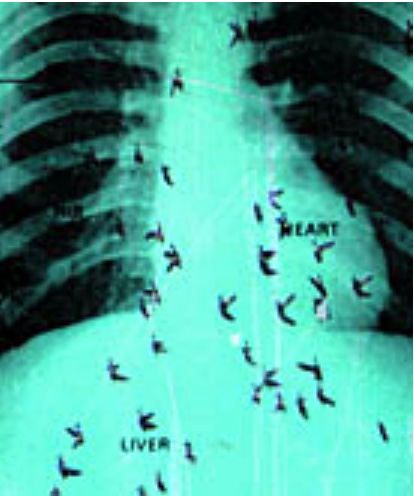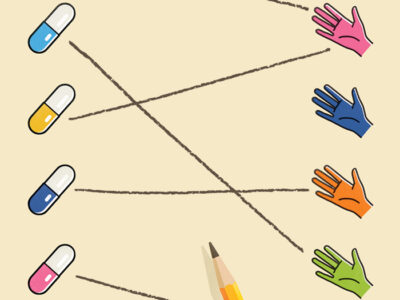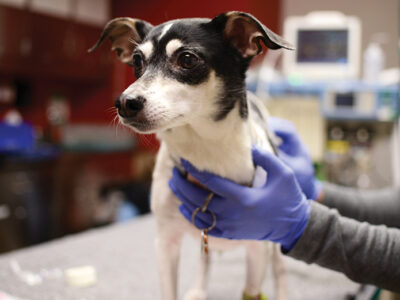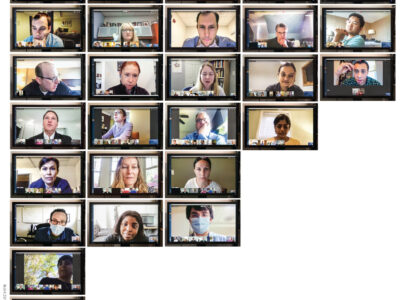
Forty years ago, a freshly-minted M.D. learned about life and death — and how to drink home-brewed beer and (almost) eat squirrel’s brains — while practicing medicine in the hills of eastern Kentucky.
By Rita Mariotii
AS FAR BACK AS I could remember I had planned on a nursing career — until, at age 13, I was walking along south Broad Street in Philadelphia, passing large brownstone buildings in which lived many of the doctors who worked at two local hospitals. How elegant and rich these homes appeared! Why settle for nursing when I could be a doctor and live in similar grandeur? I thought. My family’s poverty never entered my mind. It seemed a simple and definitive plan for a student with good grades. My parents and teachers would surely be thrilled by my resolution. They were, but they were mature enough to realize that attaining this goal was almost an impossibility for a female, let alone one with no money.
My instructors at school kindly — but strongly — discouraged my ambitions, but my parents always supported them. Years later I learned how they agonized over making the dream a reality. No one in my family had ever been to college. My parents’ simple plan was to pool my brother’s, sister’s, and father’s salaries to allocate money for my education. My time would be spent studying so I could obtain scholarships. Remarkably, it worked — not without problems, but it worked. I graduated from Penn in 1952 and went on to earn my medical degree at the Medical College of Pennsylvania.
But I did not become the prosperous South Philadelphia physician I imagined in my youth. As an intern in the late 1950s I exhibited the same air of confidence and egotism as my colleagues. We made brilliant diagnoses thanks to our proximity to book learning — and horrendous mistakes from lack of experience. We basically knew nothing about the real world. During the waning months of my internship, a sobering reality hit me: I was not ready to go into practice on my own. A medical journal promised experience, adventure, and an attractive stipend of $12,000 a year, compared to the $1,200 I earned as an intern, working for a chain of hospitals in eastern Kentucky owned and operated by the coal miners union that provided free medical care to miners plagued by chronic lung disease. Besides the stipend, the union promised pleasant working and living conditions for its medical staff, culled from all parts of the country.
I signed on and entered a very different universe. Practicing in the hills of Kentucky introduced me to unbelievable poverty, and to a commitment to patient care that never reaped great financial benefits. Medicine became a passion and a way of life that put other desires on hold.
The red brick hospital in Liggett County, Kentucky, one-tenth the size of the city hospitals of my training years, was bright and clean against a blue sky molding itself over the leek-green, tree-covered mountains. In the early morning, fog settled between the mountains like mounds of cotton balls muffling what few sounds emerged from the small town below. I loved this change from city life and enjoyed breathing cool air free of industrial fumes.
As I opened the hospital door my crisp, starched white coat almost softened from the emerging heat. Hospital odors were subdued by the smell of the fresh paint and untrodden rugs of the new hospital. My new importance impressed me. The Miners Hospital nurses stood when I entered the room, they opened the door for me, carried my charts, and reviewed the status of each patient as we made ward rounds. My smile made people think I was pleasant and easy going, but it actually represented joy and amusement at my elevation from lowly medical student and intern.
I had difficulty bonding with my first patient.
Mary Holcomb’s 350 pounds strained the small hospital bed; her fleshy arms pressed against the metal side-rails that confined them within the bed limits. She lay flat on her back, snoring heavily around the oxygen and feeding tubes that filled her mouth and nose, whose secretions crusted around the plastic invaders. She had been in these tight quarters for six months, since a stroke sent her into comatose vegetation. Three nurses acted as pulleys to shift her so that I could examine her lungs and under-surfaces. She frequently lay in watery puddles of excreta, the smell of which caused our nostrils to twitch and our stomachs to reverse gears. Remarkably, she never developed pneumonia or bed sores. Most of her medical care revolved around balancing her tube feedings to insure stools that were neither too liquid nor so firm as to require physical extraction. My inexperience and confusion about my role in this patient’s care caused me increasing agitation and dislike of the poor creature. Helpless frustration unfortunately overwhelms logic and humane responses, and my daily visits became increasingly difficult. She was still alive when I left the area a year later.
If Mary was not capable of returning my dislike, another patient, Zeke Bailey, did his best to make up for it. He hated me passionately.
“That damned woman doctor is trying to kill me,” he shouted to everyone who would listen. “She keeps taking my oxygen away. How can I breathe without it?”
Zeke’s lung capacity was limited by fibrosis from chronic black-lung disease, the result of years of working in the coal mines. With my fresh medical training, however, I knew that his metabolic condition was being compromised by continuous oxygen flow. I tried to save his life by doing what I knew was right, and merely succeeded in losing Zeke to the care of another physician when he insisted I be taken off his case.
The chronicity of so many of the hospital-bound patients made the excitement of the emergency room a welcome change, but we residents rotated this service not so much for variety but out of necessity. We were the only medical facility in a 50-mile radius, so all medical problems, emergencies, injuries, and coal-mine disasters became our struggle. It did not take long for me to realize how little medical school had taught me about life and death and most conditions in between.
Patients from Liggett County were surprised and hesitant in the presence of a female physician. It was the first such encounter for most of them. The quiet, reserved demeanor of these people could be traced to Welsh and English heritage. Their dialect was full of old English idioms which gave it a Chaucerian flavor. In fact, one of our physicians later traced much of the phraseology to Chaucer’s writings. Not that these people read such literature, but their isolation kept the language traits passing from one generation to another.
My first emergency-room patient was a miner, covered with a thick layer of coal dust that made the whites of his eyes and teeth prominent. We got used to them leaving a residue of black powder on seats when they stood up. There was always a fallout on your hand after a welcoming handshake. My black-powdered friend quietly informed me he had been bitten by a copperhead snake. The beating of my heart echoed through the empty memory chambers of my brain. Whoever treated a snake bite in Philadelphia? Fortunately, the patient and nurse were skilled in such treatment. When bitten, the miner had placed a tourniquet around his lower leg and suctioned the wound. My efficient nurse led me to the snake-venom antisera, assuring me that a successful cure was available for this common emergency.
In the adjoining room a pale, thin girl lay on the gurney. She appeared much younger than the 12 years registered on the chart. Her mother wore the typical look of a miner’s wife: Non-smiling, thin gray lips; worry lines pressed deep into colorless cheeks; expressionless eyes staring from under straight, prematurely graying hair. Two smaller children hung on her loose-fitting, black-and-white checkered dress, and wiped their noses on shabby, frayed coat sleeves. The mother’s tender caress as she stroked the face of the sick child, Peggy, belied her outward appearance of disinterest.
Peggy’s eyes were sunken. Suddenly, she raised her head from the stretcher, her arm groping in the air in an agitated, pleading way. Then it came. A projectile tide of vomit missing the emesis basin that the attentive nurse had produced when she understood the reason for the child’s flapping arm. Floating in this bilious mess were three large, fat, roundworms. Seeing the six by one-half inch creatures caused me to draw back uncontrollably and run from the emergency room. When the nurse got everything cleaned, she ushered me back into the room and quietly suggested we proceed with arrangements to admit the child. Peggy was well known to the emergency room staff. She and her family had been treated many times for recurrent Ascaris worm infestations. Her case, however, had been resistant to treatment, and she gradually worsened. A few days after being admitted to the hospital she went into a coma as the worms entered her central nervous system.
It was not difficult to understand why worms were such a problem in eastern Kentucky. Patients lived in one- or two-room shacks, which frequently housed six to eight children, plus parents. An outhouse was some distance away, and it was not unusual for the children to defecate around the house rather than walk to it. Winter or summer, the children went bare-foot. Refuse was carried in and about the house. With no running water, hand washing was not readily available. Such lack of cleanliness ensured constant reproduction of worm ova carried by the oral-fecal route.
That evening I walked across the hospital grounds toward my apartment wanting to put the events of the day behind me. The cool October breeze was refreshing. The tree in front of the apartment complex had a few remaining apples hanging heavily on tired branches. I picked a nice red one, bit into it, and a tiny white worm wiggled a defiant dance.
LIVING ALONE was a joy. I learned to enjoy privacy and isolation without ever feeling lonely. My furnished efficiency apartment was one of 20 built by the United Mine Workers Union to house the incoming staff of doctors and nurses. Ten adjacent apartments on the top floor and an equal number below were reached by outside metal corridors. It was difficult to sneak in without being heard; it was a struggle not to hear your neighbors through the thin walls. The windows looked toward the grounds and creek behind the hospital and beyond to the mountains. Sipping Southern Comfort on the rocks as I shook my feet out of hospital shoes and into warm slippers, I felt positively ante-bellum.
My tiny kitchen offered me new experiences of the joy of cooking. One is not raised in an Italian family without appreciating food and wine. Fine eating was part of my heritage. Discovering how to produce it on my own became a passion.
When I first arrived in Kentucky, my new wealth made me want to accumulate even more. I learned how to cook cheaply. One of my favorite creations was a stew made from browned chicken necks, wings, and backs, simmered with fresh carrots, celery, and onions. Perked by wine and herbs and served over steamed rice it became an elegant meal — especially when accompanied by the Rhine wine I had recently discovered. I enjoy it to this day, although I have never served it to anyone else. How many of the sophisticated friends of my retirement years would really enjoy a meal made from such humble chicken parts?
Pizza was unknown in Appalachia. I made the dough from flour and yeast. The standard toppings of tomato, olive oil, garlic, and mozzarella cheese melted sensuously over the homemade brown crust. The strange smell seeped through the windows and doors and drew an assortment of curious — and hungry — neighbors, who were more than willing to experiment with a food that produced such an enticing aroma.
I, too, learned to eat unusual and sometimes eccentric foods. Sam, a male nurse from Harlan, Kentucky, so enjoyed his first experience with pizza that he invited me home to sample his family’s “special dish.” He refused to tell me more because he wanted it to be a complete surprise.
Sam and his wife, Polly, greeted me at their home enthusiastically. (The sincerity and friendship of the people of eastern Kentucky has never been surpassed by any others I have known around the world. I accepted this hospitality humbly and always felt regally treated.)
Home-brewed beer was the harbinger of local entertainment. A frothy, heady start it was. One taste and a lifelong love affair with malt ensued. I brew small cauldrons to this day, but selfishly hoard the distillation in my private stash. It never tastes like its Kentucky ancestor. The flavors added by the huge outdoor stills and lack of sterility are missing, as well as the savored joy imbued by the excitement of hiding from government revenuers. (Fortunately, I never developed a taste for illegal home-distilled spirits, or White Lightning — a vile and dangerous concoction reserved for serious consumption. A sip burned the pillars of the tongue, singed the esophagus, and came to a final rest in a liver whose cells gave up their lives for the owner’s drunken pleasures.)
I was on my third beer when Polly proudly graced the table with the favorite dish. An enticing, hearty odor rose from the country crock, which held a hunter’s stew of muskrat, raccoon, and squirrel. This would normally have shaken me. Dishes using these animal ingredients did not exist in any of my recipe files. However, the appetizing odors, mixed with the softening effects of the beer, made the meal more than memorable. I was happily bread-mopping the remaining sauce when Sam joyfully presented me with a special treat. As guest of honor, I was offered the squirrel’s skull to suck out what was considered the best part of the meal: the squirrel’s brains. I could not do it. I could not raise that tiny white head to my lips and suck the contents through the eye socket. In an eternal second my mental computers analyzed all acceptable and courteous denials.
They all failed.
“I am so sorry,” was my pitiful response, “I am just too full.”
I CAME TO HATE THE telephone. I used to spend hours conniving a way to keep nurses’ home phones ringing all night after they woke me repeatedly to request sleeping pills for insomniac patients. When it rang for a bona fide emergency, there was no time to think as you threw yourself into hospital clothes and ran the short distance across the grounds to the emergency room.
Jesse Stuart lay quietly on the ER bed clutching his chest. His wide eyes spoke the fear that his tongue could not express. His vital signs were stable and the injected morphine produced almost instant relief from his chest pain. His eyelids relaxed and covered soft brown eyes. After blood was drawn for analysis, the intravenous fluid ran through the needle keeping a patent pathway; oxygen flowed via a nasal catheter. We moved him on his bed to a small private room to do an electrocardiogram. There were no monitoring screens, no elaborate electrical connections, no rush of nurses or other staff members. Just the patient, doctor, one nurse, intravenous tube, nasal oxygen, and morphine. This was 1959. This was an isolated hospital in the hills of depressed Appalachia. The electrocardiogram confirmed a myocardial infarction and heparin was added to the treatment.
Jesse’s wife had the same lack of expression that was typical of miners’ wives. She did, however, appear to be relieved when I told her Jesse was resting comfortably, and that everything we could do was being done. Mrs. Stuart returned to the waiting room, and I settled down to a long night of observation. I kept seeing Jesse’s anxious eyes; their sense of fear and danger was contagious.
The stillness of the room was interrupted by a groan. The whites of Jesse’s eyes rolled to prominence as his breath stopped. The stethoscope registered only my own heart thumping in my ears. There were no peripheral pulses. Pupils high in their sockets dilated. His face and hair were slick with sweat. Thwack! My fist hit his chest — once — twice. Nothing. My mouth girded his as I blew hot, nervous breath into his lungs. Thwack! — again. Nothing. As I screamed for the nurse I found the vial of adrenaline on the emergency cart and drew up 1cc into a syringe fitted with a four-inch cardiac needle. My fingers slid over the left fifth anterior rib on to the soft intercostal space above. With the needle poised I entered the skin and muscle, and pushed into more resistant cardiac musculature. When blood swirled up into the syringe I plunged the fluid into the left ventricle, withdrew the needle, and released my breath. My hand resting on his chest felt his heart and mine beating as one. The nurse was there in an instant and we both were encouraged by the return of a few heart beats. It did not last. The quivering fibrillation of a dying heart refused to reverse. It was 1959: there was no electric cardioversion. There was nothing more I could do; Jesse died.
The sense of hopelessness and despondency over the loss of a patient never changes, even after 40 years of practicing medicine. Feelings of inadequacy and anger plague you. Could something else have been done? Could the death have been prevented? With a mind twisted by doubts, the body somehow finds the courage to inform the family and give needed support. Death is the single most difficult problem a physician must face, and it never gets easier.
I walked the hospital floors while the body traveled to the morgue. The quiet of the night was roughened by an occasional distant snore, and the sound of nurses’ heels receding along shining linoleum corridors. As I passed Jesse’s room a small light reflected over the crumpled sheets on his empty bed. I stared, haunted by the memory of fear in his eyes. I realized then that he knew he was going to die. Tomorrow I would complain to my colleagues about losing sleep and spending an unsuccessful night on call. We frequently joked and made accusations to hide the hurt felt after losing a patient. Tonight, however, I walked to the bed, lay on the sheets still moist from Jesse’s sweat, and wept.
Dr. Rita Mariotti, CW’52, is working on a book about her early experiences as a doctor in Kentucky. This article was excerpted from the first three chapters.




